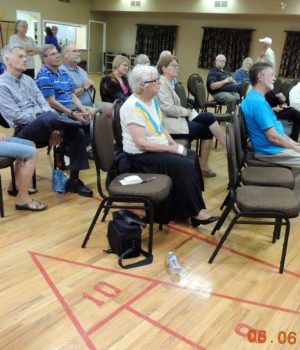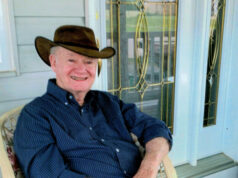By BOB GRYLLS
Special to Whitewaternews.ca
WESTMEATH — The Riverview Seniors Social Club held its first Speakers Series event on Monday, June 6. This Series is being provided with a funding grant from the New Horizons for Seniors Program.
Guest speaker Dr. Brian McGaffney gave a presentation on “Exploring the Night Sky” at the Westmeath Hall, one that was tailored to novices and experts alike. The only physicist around that doesn’t work for AECL, he owns and operates The Nutwood Conservatory & Dark Sky Preserve near Bancroft.
Dr. McGaffney enlightened his enthusiastic audience of 30 people about Astronomy being the mother of all sciences. It is important to understand Astronomy, as someday we will have to vacate our Milky Way galaxy for another, as it and the galaxy of Andromeda are on a collision course – but not to make impact for a few million years yet.
He had photos of some different galaxies taken with telescopes at his conservatory, only a small percentage of the 80 billion in the universe. Our own spiral galaxy consists of a flat disk, a bulging centre and surrounding spiral arms. The galaxy’s disk includes stars, planets, dust, and dark matter, all held together by gravity.
Supernovas (astronomical events during the last stage of a massive star’s life in one final titanic explosion) were explained, as were comets with their greenish tinge caused by the burning of oxygen. Stars become one of three types: nebulas, pulsars or a black hole. Stars too, obey the same laws of physics as the sun. Their patterns or constellations in the heavens take on familiar shapes such as Orion the Hunter or the Big Dipper.
The second part is where all participants will go into the “automated roll-off-the-roof” observatory and will look at the night sky through two large telescopes (either a 10 inch SCT scope or a 20 inch Dobsonian).
After that if time permits and there is enough interest, we will go into the main control room and see where the computers control the observatories remotely. We will also take a look at how some of the “Deep Space Images” are acquired.
Dr. McGaffney’s images shown to the group were minute details of the sun, the bright colours of the milky way and other galaxies were fantastic. All were taken in his observatory with two large telescopes.
Putting the vastness of space in perspective, to travel the width of our galaxy would take 150,000 light years. Cobden doesn’t seem that far away after all.







![Kenopic/Smith Auction [Paid Ad]](https://whitewaternews.ca/wp-content/uploads/2018/10/advertising-100x75.jpeg)

